

Close-Ended Questions: Best ways to get quality insights in 2023
source link: https://usersnap.com/blog/close-ended-questions/
Go to the source link to view the article. You can view the picture content, updated content and better typesetting reading experience. If the link is broken, please click the button below to view the snapshot at that time.
Close-Ended Questions – How to Get Quality Insights for Your Customer Feedback
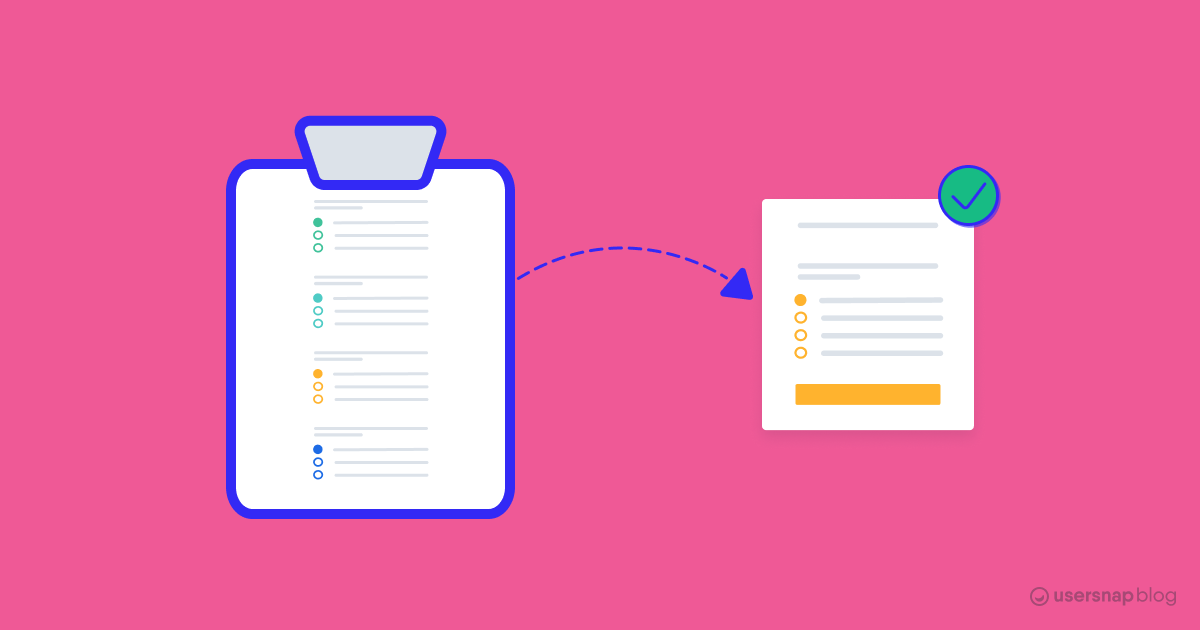
Learning about your customers’ needs is sometimes like being a 1-person paddle boat upstream. Particularly when you don’t have the right tools or questions, it’s a lot of effort just to understand them, much less to execute on what you can learn. When you need to get a large amount of data quickly and easily, one of the best approaches to gather customer feedback data is using closed-ended questions. They’re a great way to conduct survey research effectively with a large audience, and help to avoid tiring your customers.
In this article we’ll explain the difference between close-ended & open-ended questions, and we’ve compiled the ultimate list of sample questions.
What are Close-Ended Questions?
Close-ended questions are great for brief answers to simple questions. They’re also the most convenient surveying method for your customers. Long questions can often deter or discourage your customer from participating in a survey.
Close-ended questions require short fixed responses. Limiting the available answers makes it easier to analyze your data and act accordingly.
Close-ended questions are common in multiple-choice questions and surveys. Product survey questions can benefit from close-ended questions, as they might provide higher response rates.
“There are many advantages of using closed-ended survey questions, especially when you desire to receive a high response rate from your busy customers.”
Case Study: How Usersnap can Help you use Open-Ended Questions
To capture open-ended questions, select the short answer or long answer fields for your Usersnap survey. The size of the field and the placeholder text will guide survey participants to give the depth of insights you want to learn.
What’s most special about Usersnap’s feedback tools, is the visual feedback screen capture capabilities. For digital product teams, allowing your customers to take a screenshot to explain or compliment their feedback is highly convenient and smart. Users can record a video of their screen as well as enable audio to directly speak to you about their experiences or issues.
Getting to Know the Types of Closed-Ended Questions

There are many forms of closed-ended questions, and using the right one is best for the most accurate results. Yes or no questions are the simplest form of closed-ended questions.
Closed-ended questions examples include multiple-choice, ranking questions, checkboxes, drop-downs, and rating scales.
Our close-ended questions examples are kept simple and to the point – adding too much detail can limit your customer and result in a rushed answer.
Usersnap has many templates that can help you create impactful close-ended questions that help your surveys stand out.
Dichotomous Questions
Dichotomous questions are limited to two answer results. The answer results are simple, varying from yes or no, to true and false, or blue and black or white and gold 😉. Agree or disagree is also another option.
These two response answers are a great way to include many questions in your survey without tiring your respondent.
Examples of Dichotomous Questions
A simple example of a dichotomous question is “Was your support issue resolved?”. It’s easily answered with a yes or no.
For true or false, an example would be “Is the sky blue?”. When using agree or disagree, a good example would be “Is stealing bad?”.
Among all closed-ended question examples for surveys, this one would be the most basic.
How Usersnap lets you Add Multiple-Choice Surveys
The radio button poll question type on Usersnap allows you to customize the possible answers. After you’ve collected your responses, you’ll get a donut chart in your project statistics page on Usersnap to view and analyze the results. Try using simple words and adding emojis to the answer options to make it more engaging.
Multiple-Choice Questions
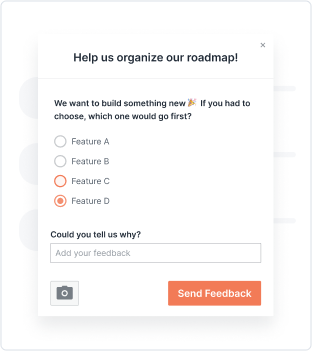
Multiple-choice questions are the most common method of questions used in most surveys and research. These questions include several responses and are very flexible, allowing for a wide variety of questions.
Examples of Multiple-Choice Questions
A good example of a multiple-choice question would be, “Which feature of the product did you like the most?”. Responses will list features that you want to measure and see how many customers like them.
Another popular example is “How did you hear about us?”. Possible answers are social media platforms, word of mouth, and others.
Among all closed-ended survey questions examples, multiple-choice questions are the most flexible.
Rating Scale Questions

Rating scales let you to assess the degree of agreeableness your customer has regarding a question. This way, you can gauge the success or rating of a particular aspect of your business.
By having your customer rate a question out of five, you can accurately see how your respondent corresponds to your statement.
Rating scale questions can be superior to open-ended questions as they grasp the initial thought of your consumer.
Rating scale questions are frequently seen in user acceptance testing to see how successful new features are.
Examples of Rating Scale Questions
An example of a rating scale question would be, “How satisfied were you with your ability to find what you were looking for?”. A 1 means strongly disagree, while 5 means strongly agree.
Another example would be, “How likely are you to repurchase?”.
Here’s a few more samples of rating scale questions:
- Does the Product feature make it easy for me to accomplish my task?
1 = Strongly disagree to 5 = Strongly agree - Are you satisfied with the product’s quality?
1 = Strongly disagree to 5 = Strongly agree - Did the [product/service] help you to reach your goals?
1 = Strongly disagree to 5 = Strongly agree - Was your use of the [brand/service] a positive one?
1 = Strongly disagree to 5 = Strongly agree - How would you rate the service you have just received?
1 = Strongly disagree to 5 = Strongly agree - How would you rate your experience with our company?
1 = Strongly disagree to 5 = Strongly agree
Using Usersnap to Create Rating Surveys
Now that you’ve learned about a few types of survey types, you’re probably wondering what’s the best way to get started? Here’s how we do it:
Usersnap offers multiple rating scales to send close-ended microsurveys, including 5-star rating, 10-scale number rating – typically used for NPS, thumbs up/down binary rating, emoji ratings, and text radio buttons.
Measure customer sentiment and user experiences (UX) with Usersnap’s rating microsurveys. They’re easy and quick to respond to, which will guarantee more feedback, and also simple to analyze and gain insights. When sending microsurveys on a website or in-product, be sure that it’s not too invasive. Two tips from Usersnap when setting up your survey: select the “bottom left” or “bottom right” modal position, and use the floating mode instead of blocking mode. The floating mode means the widget doesn’t interfere with whatever the users are doing on the page, and they can click to answer the survey when they like.
Rank Order Questions
Another method to cut down on open-ended questions is to use rank-order questions. You can ask questions that have your participant rank their preferences in ascending to descending order.
Through this, you can determine what your customers care more about and what is least relevant to them. This is a great way to ask important questions shortly and quickly.
Examples of Rank Order Questions

With this example, the surveyor can quickly determine what matters the most to respondents. They avoid the need for a lengthy explanation with unnecessary information.
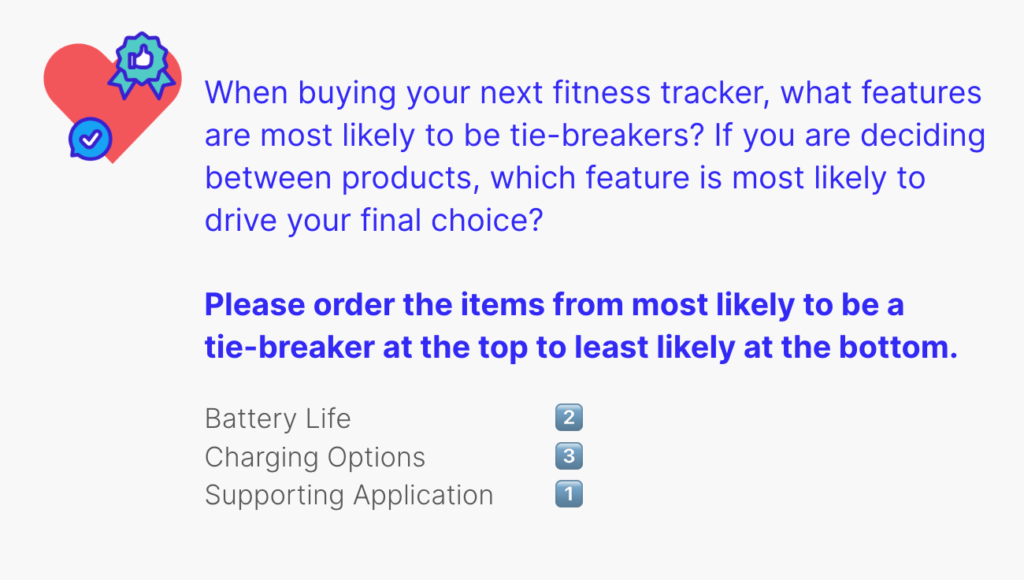
Here’s another example of a survey question with vital information. The company here notices that users prioritize supporting applications most and will be able to divert more focus in that area and less towards battery life.
We’ve prepared more examples for your inspiration:
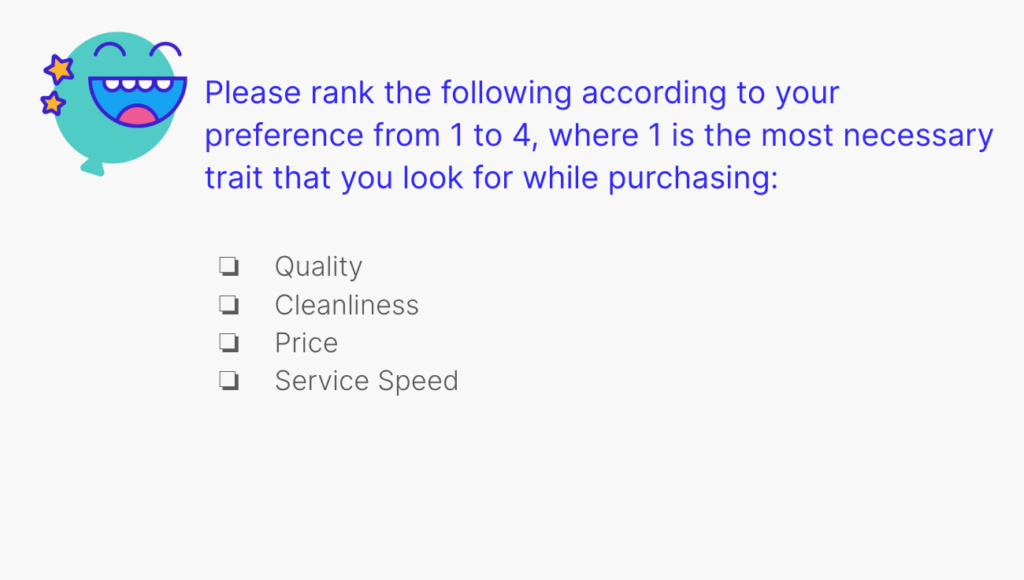
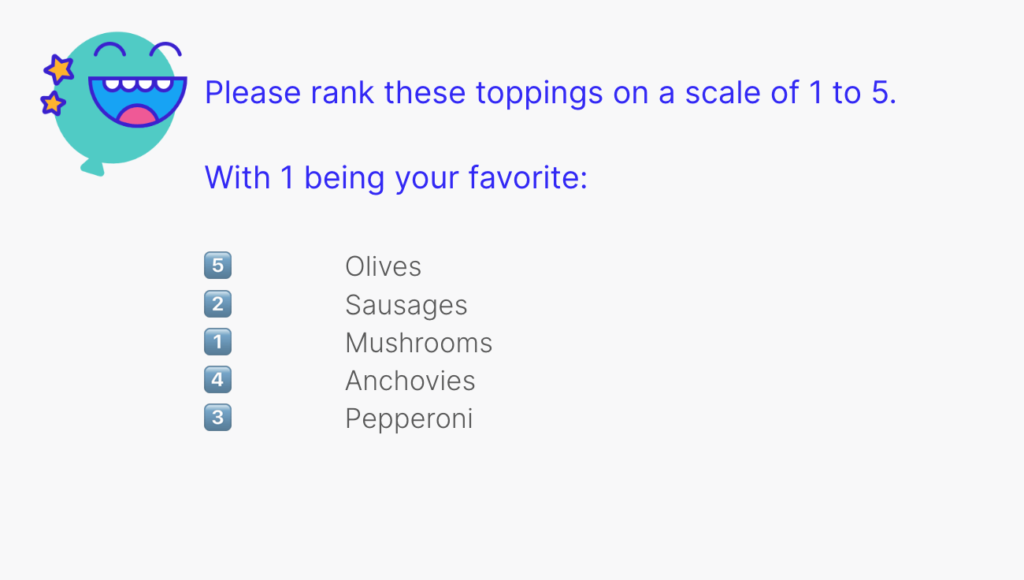
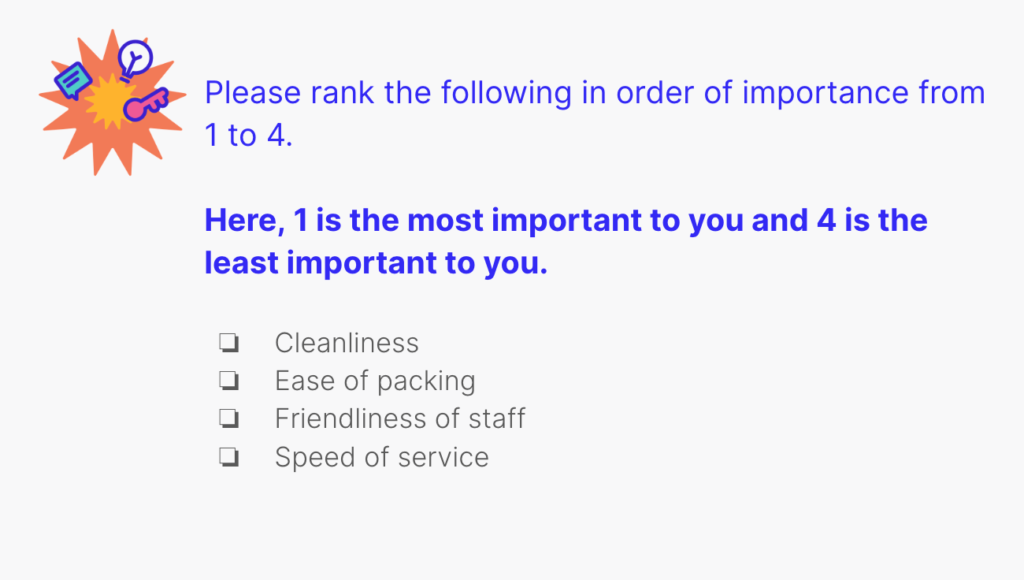

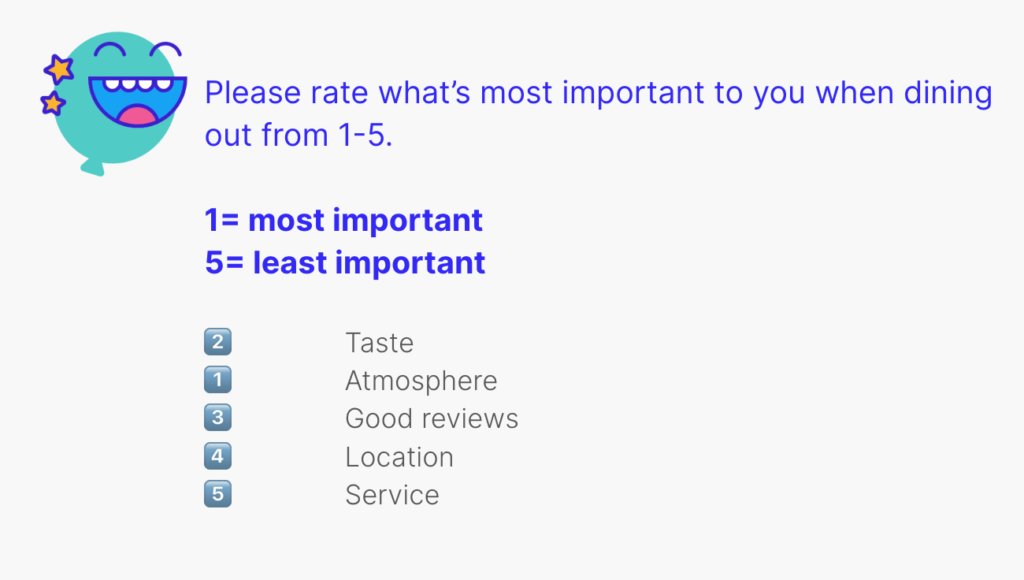


Checklist-Style Questions
Checklist-style questions are another fast method to gather data that might appear mundane to your respondent. Allowing the option to select multiple options from your predetermined list of answers will encourage them to answer.
These questions require careful analysis, but they help capture data that is easy to analyze.
Examples of Checklist-style Questions
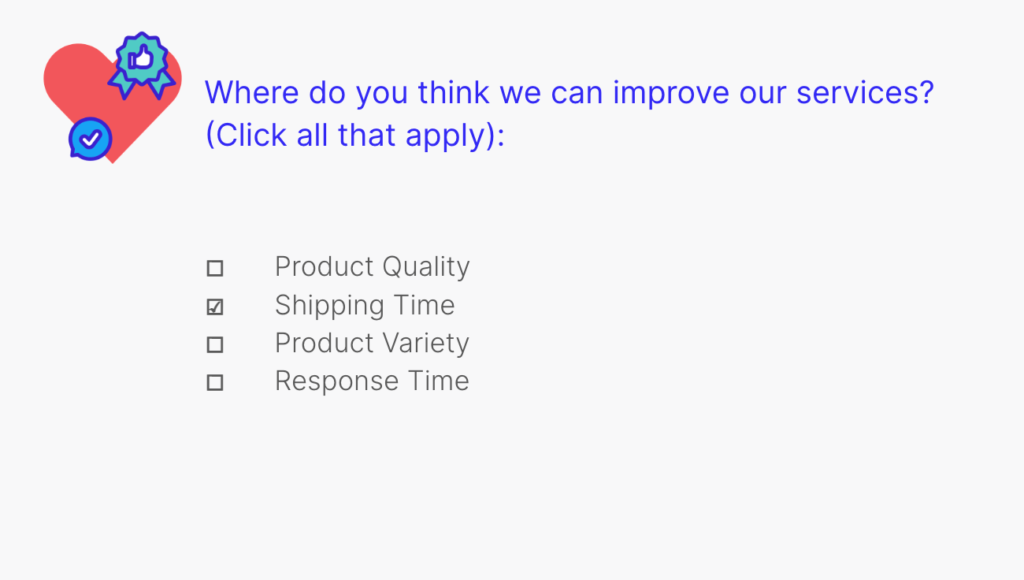
With this question, you can quickly determine which areas your business might be lacking. Using this in a checklist-style question over a rank-order question will allow for faster answering.
If the respondent selects two options, then you can determine that the other two areas are in no need of improvement.
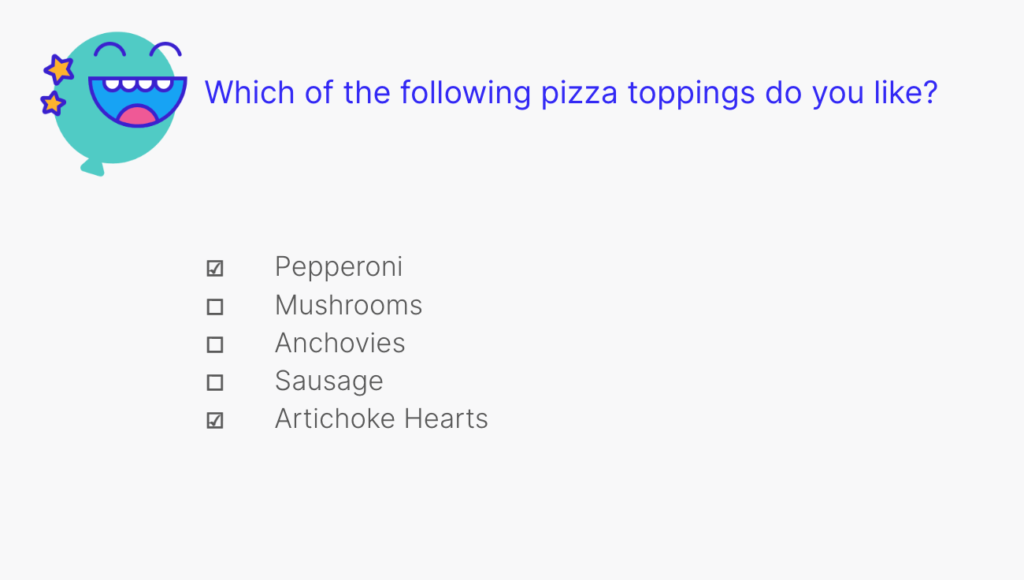
This is also another example that would provide useful insight into what your customers care about.
The company may decide that utilizing anchovies as toppings is futile and move on to a different topping that might be more popular if the survey findings show that anchovies are not a popular item.
Here are a few more checklist-style questions.


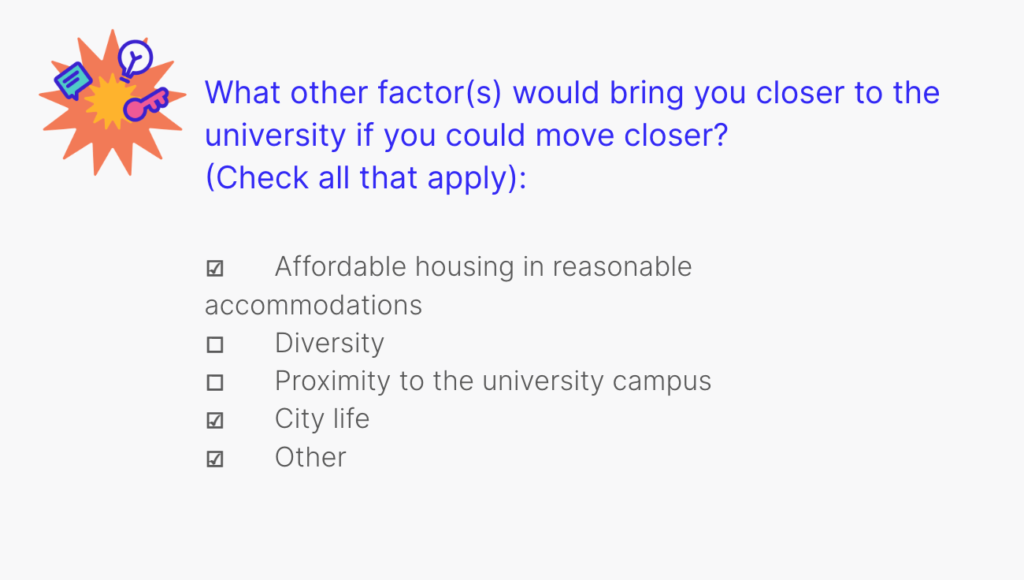
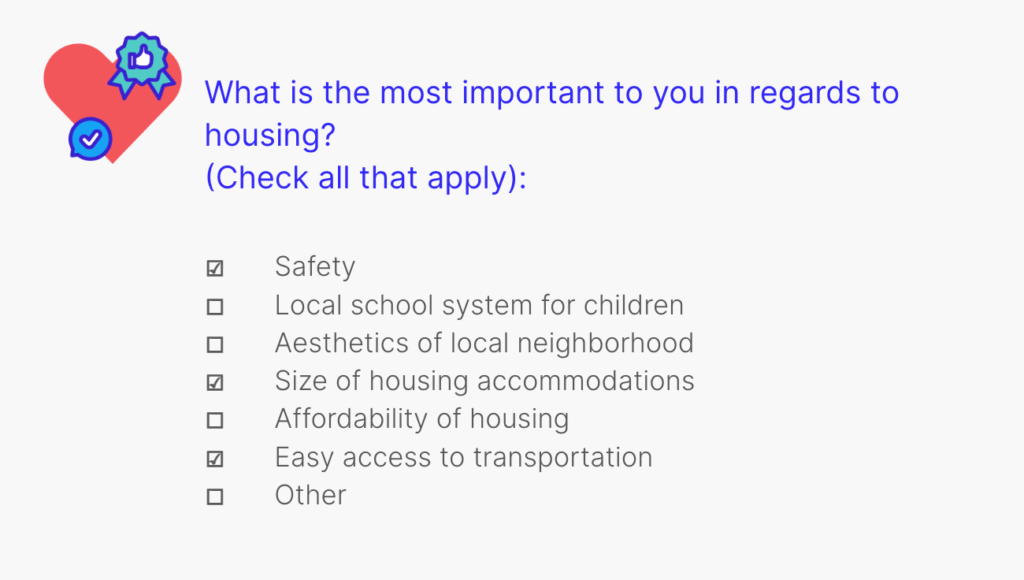
What’s the Real Difference Between Open-Ended And Close-Ended Questions
Understanding the differences between close-ended questions and open-ended questions is crucial in choosing which you need.
When you Should Use Close-Ended Questions
Knowing when to use close-ended questions can help you create surveys that are convenient to answer for your participants.
When the Audience Is Not Interested In Survey
People have busy schedules and not everyone might be keen on answering questions in their free time. Using close-ended questions is the best solution to keeping your survey short and to the point.
Using too many open-ended questions can result in a survey with a low completion rate.
You can also add fun ideas like would you rather questions to add some spice to your surveys; this works great on younger audiences.
When You Need Quantifiable Data
Using close-ended questions is a great way to gather lots of quantifiable data. This will make it easier to measure. These questions are easy to create and provide statistical data that is imperative to your research.
Quantifiable data is best used to estimate an issue or figure out a quantity regarding a specific matter. This data is counted easily and provides information that requires further analysis.
To Categorize Respondents
One of the best ways to create demographic studies is to use close-ended questions. Questions include age, employment status, gender, and other relevant questions.
Demographic studies help you understand your customers and will lay a foundation for future studies.
When you Should use Open-Ended Questions

Open-ended questions can be beneficial in specific instances requiring unfiltered answers.
To Conduct Expert Interviews
Open-ended questions require answers past a simple yes or no. The response needs to evoke critical thinking and get an uncut opinion from your respondent.
These types of questions work best when interviewing industry field specialists. The goal is to expand your knowledge in a specific area from a more skilled individual.
For Small Population Studies
When surveying a small group of individuals, you may benefit more from a deeper survey. Statistical data will have less relevance, and you will gain more insightful information using open-ended questions.
Each respondent will provide information, and analysis will be possible due to the small number of participants.
Preliminary Research
A good way to discover new varieties of opinions is to ask open-ended questions; this can result in new ideas, which can be the basis for quantitative research.
Open-ended questions will introduce new ideas that will require further research.
| Don’t (Closed) | Do (Open) |
| Are you satisfied? | How satisfied or dissatisfied are you with this process? |
| Did it act as you expected? | What would (did) you expect to happen when you …? |
| Did you find it? | Before a task: • Please tell me when you’ve found the item. • Explain how you would find that. After a task: • Where did you find the answer? • Where was the item? • What did you find? |
| Do you think you would use this? | How would you fit this into your work?How might this change the way you do that today? |
| Does that work for you? | What do you think about that? |
Getting the Most out of Close-Ended Questions with Usersnap
Two key takeaways we’ve learned from the thousands of companies using Usersnap:
- First, the answer options in close-ended questionnaires need to be clear and specific. If the description doesn’t reflect what your customers think or do, then they will not be comfortable in selecting an answer. A basic understanding of your users and their language is important to craft close-ended questions.
- Second, the timing of your survey will influence the answer rate and answers. The best timing is after customers have fully completed an experience, but not too long after so that the memory is still fresh. For example, you released a new statistics page on your product, and want to find out how easy it is to use the analysis features. The optimal timing would be after the users have clicked on the page elements or have stayed on the page for a reasonable amount of time.
Usersnap is designed to let you configure the timing of the survey distribution easily. As you can see above, you can target the people on that specific page after X amount of time on a page, or trigger the survey after a user behavior event with an API event.
Capture feedback easily. Get more insights and confidence.
Getting feedback has never been easier and we hope you’ve realized that after reading this article. Let us know what you think, your feedback is important.
And if you’re ready to try out a customer feedback software, Usersnap offers a free trial. Sign up today or book a demo with our feedback specialists.
Recommend
About Joyk
Aggregate valuable and interesting links.
Joyk means Joy of geeK